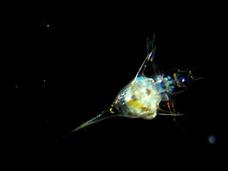Be Smart
You'll Never Guess Where Earth's Largest Migration Happens
The biggest (and most mysterious!) migration in the world happens every night in the ocean as 10 billion tons of zooplankton swim to the surface to feed. This undersea journey is known as Diel vertical migration, and it occurs in every...
SciShow
Man Made Earthquakes and More
Hank hits you with a ton of news this time - Amazon CEO Jeff Bezos has plans to retrieve Saturn V rocket engines from the bottom of the Atlantic; new research on the impacts from the Deep Water Horizon oil spill to life in the Gulf of...
SciShow Kids
Using Our Senses to Explore the Beach! | Science at the Beach! | SciShow Kids
Squeaks went on a trip to the beach, and wants to tell Mister Brown all about it! And, we can learn all about the science that formed the beach, plus a guest appearance by Grady the tardigrade to talk all about the plants and animals in...
SciShow
6 Seriously Impressive Animal Migrations
There are some seriously impressive journeys that animals will undertake to avoid the cold, to give birth, or to find food. All kinds of creatures migrate that you might not think about; some big and familiar, and others so small, you...
SciShow
9 of the Most Abundant Animals on Earth
Check out nine abundant animals that help support the food chain in their ecosystems!
TED-Ed
TED-ED: Jellyfish predate dinosaurs. How have they survived so long? - David Gruber
Some are longer than a blue whale. Others are barely larger than a grain of sand. One species unleashes one of the most deadly venoms on earth; another holds a secret that's behind some of the greatest breakthroughs in biology. They've...
SciShow
An Ode to Salps: Our Gelatinous Marine Cousins
Salps are more than just strange balls of goo drifting through the sea—in fact, they’re more closely related to us than they are to jellyfish, and play a huge role in marine ecosystems and the global carbon cycle as the “vacuum cleaners...
Curated Video
Food Chain - Energy Flow in Ecosystems
A food chain simply states which organisms consume each other, and shows how energy moves through living things in an ecosystem. A Twig Science Glossary Film. Key scientific terms defined in just 60 seconds using stunning images and...
Curated Video
Creating Floating Islands to Protect Zooplankton and Control Algae in British Waterways
In an effort to protect zooplankton from being eaten by carp and control toxic blue-green algae, two man-made islands have been created in the Earlswood Lakes of Britain's West Midlands. Scientists have carefully planted five different...
Financial Times
Can society turn down damaging levels of light pollution?
FT Rethink - Artificial light is proving to be an ever-growing threat to biodiversity. It's harmful to pollinating insects, bats and a host of other creatures, including zooplankton, and remains a crucial part of the aquatic food chain....
Nature League
Exploring Invertebrates | Compilation
Brit looks back on our third month on Nature League, when we explored the theme of invertebrates.
Independent Producers
The Changing Ecosystem of the Bering Sea
Ice is an essential component of the ecosystem of the Bering Sea region. For example, sea ice cover can dramatically affect the levels of phytoplankton which has enormous effects on the entire food web. In this public radio story we hear...
Nature League
Searching for Mysis Shrimp - Field Trip
In this Nature League Field Trip, Brit joins researchers at the University of Montana Flathead Lake Biological Station to sample for freshwater invertebrates, including Mysis shrimp. Thanks to Dr. Jim Elser for being our field guide at...
Professor Dave Explains
Phylum Cnidaria Part 1: Introduction and Broad Characteristics
Next up for animal phyla is Cnidaria! This phylum contains jellyfish, sea anemones, corals, and all kinds of other organisms. This one is pretty meaty so it will take several tutorials. Let's start by getting through some information...
Nature League
Invertebrates and Ocean Mixing - De-Natured
In this De-Natured segment of Nature League, Brit breaks down a recent scientific journal article about the impact of invertebrate motion on the mixing of water columns. Article citation: Isabel A. Houghton, Jeffrey R. Koseff, Stephen G....
NASA
Two Research Vessels Leave for the Twilight Zone
A project jointly funded by NASA and the National Science Foundation is heading west from Seattle, straight for the twilight zone. Using two research vessels, the Export Processes in the Ocean from Remote Sensing (EXPORTS) oceanographic...
Visual Learning Systems
Water: Ocean Life
Characteristics of various ocean zones, including variations in ocean temperature, salinity, and depth are discussed. The different groups of marine life and adaptations of plants and animals are highlighted. Estuaries and various...
Nature League
Invertebrates and Ocean Mixing - De-Natured
It's time to mix things up! Introduce biology scholars to the latest topic in marine research—invertebrates! The third installment in a five-part series of Invertebrates lessons explains the hypothesis that tiny, migrating shrimp are...
Nature League
Searching for Mysis Shrimp - Field Trip
Surely, the biggest fish in the lake will benefit from a meal of big, tasty shrimp! Take biology scholars on a trip to Flathead Lake in the second of a five-part Invertebrates series. Scientists currently studying the lake take the...
Deep Look
From Drifter to Dynamo: The Story of Plankton
Even the smallest living things have a large impact. An informative video lesson presents an introduction to types of plankton and their roles in the ocean. The narrator explains how plankton impacts the ocean ecosystem and beyond.
NOAA
Noaa: Estuary Education: Plankton Parade
Students learn about the importance of zooplankton and phytoplankton, and why different plankton species are the basis of the estuary food web. [3:25]




